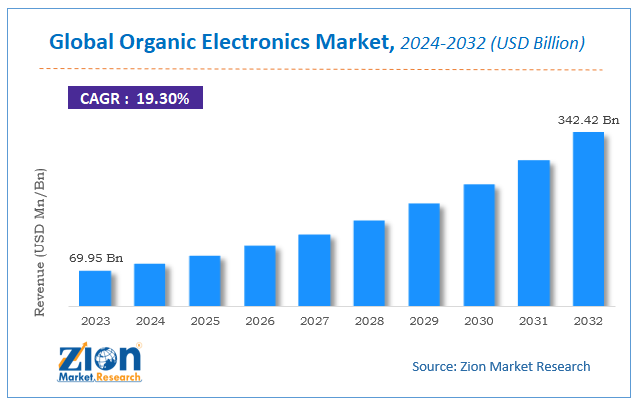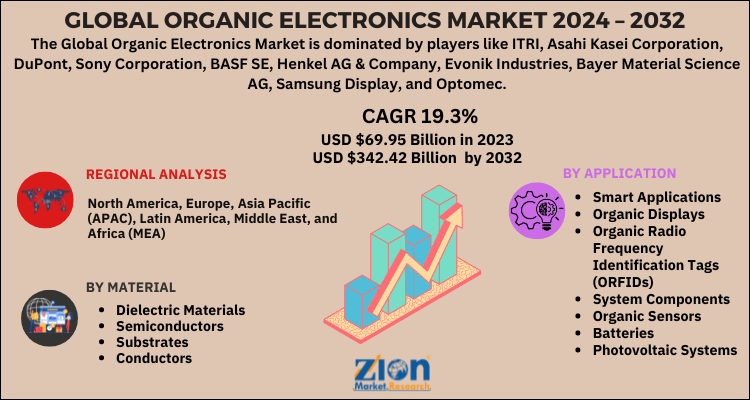Organic Electronics Market Demand, Size, Share & Forecast 2032

Organic Electronics Market By Application (Smart Applications, Organic Displays, Organic Radio Frequency Identification Tags (ORFIDs), System Components, Organic Sensors, Batteries, Photovoltaic Systems), By Material Used (Dielectric Materials, Semiconductors, Substrates, Conductors), and By Region: Global Industry Analysis, Size, Share, Growth, Trends, and Forecast, 2024-2032
| Market Size in 2023 | Market Forecast in 2032 | CAGR (in %) | Base Year |
|---|---|---|---|
| USD 69.95 Billion | USD 342.42 Billion | 19.3% | 2023 |
Description
Organic Electronics Market Insights
According to the report published by Zion Market Research, the global Organic Electronics Market size was valued at USD 69.95 Billion in 2023 and is predicted to reach USD 342.42 Billion by the end of 2032. The market is expected to grow with a CAGR of 19.3% during the forecast period. The report analyzes the global Organic Electronics Market's growth drivers, restraints, and impact on demand during the forecast period. It will also help navigate and explore the rising opportunities in the Organic Electronics industry.
Global Organic Electronics Market: Overview
Organic electronics is a branch of material science that deals with the application, design, and formulation of organic materials, which possess desirable electronic properties such as conductivity. These materials are composed of carbon-based polymers hence known as plastic electronics or polymer electronics. Compared to inorganic electronics, organic electronics offers the benefit of low-cost manufacturing. It is environment-friendly in nature and also provides better resource utilization. Various kinds of materials are used in the manufacturing of organic electronics such as carbon-based molecular structures, polymers, hybrid materials, nanotubes, and graphenes.
The most common application of organic materials is an organic light-emitting diode (OLED) which is broadly used in smartphones. Transistors, television displays, and organic solar cells are other applications of organic electronics. Organic electronics are managed at room temperature and can be produced in bulk cheaply. They are brighter, more flexible, and consume less power.
Global Organic Electronics Market: Growth Factors
Organic electronics are used in various applications such as photovoltaics, OLED lighting, ORFID, and others. It helps in reducing power consumption, cost, and weight of electronic goods thus driving the global organic electronics market. Millions of tablets, TV sets, smartphones, and PCs are being exported globally thus fostering the market growth. Similarly, the demand for other flexible electronic goods may escalate in sectors such as government, healthcare, and others. However, lack of robustness and non-compatibility with conventional electronic goods are factors that restrain the global market growth to some extent.
Global Organic Electronics Market: Segmentation
The global organic electronics market is segmented into its application, material used, and geography.
Based on the application, the global market is divided into smart applications, organic displays, organic radio frequency identification tags (ORFIDs), system components, organic sensors, batteries, and photovoltaic systems. The organic display is the dominating segment. While, OLED displays are used in lighting, laptops, T.V. sets, and tablets.
Based on the material used, the global organic electronics market is segregated into dielectric materials, semiconductors, substrates, and conductors. Regionally, the market is diversified into Asia-Pacific, Europe, North America, Latin America, and the Middle East and Africa.
Organic Electronics Market Growth Size, Share, and Forecast, 2024 - 2032: Report Scope
| Report Attributes | Report Details |
|---|---|
| Report Name | Organic Electronics Market Growth Size, Share and Forecast, 2024 - 2032 |
| Market Size in 2023 | USD 69.95 Billion |
| Market Forecast in 2032 | USD 342.42 Billion |
| Growth Rate | CAGR of 19.3% |
| Number of Pages | 193 |
| Key Companies Covered | ITRI, Asahi Kasei Corporation, DuPont, Sony Corporation, BASF SE, Henkel AG & Company, Evonik Industries, Bayer Material Science AG, Samsung Display, and Optomec |
| Segments Covered | By Application, By Material Used, and By Region |
| Regions Covered | North America, Europe, Asia Pacific (APAC), Latin America, Middle East, and Africa (MEA) |
| Base Year | 2023 |
| Historical Year | 2018 to 2022 |
| Forecast Year | 2024 - 2032 |
| Customization Scope | Avail customized purchase options to meet your exact research needs. Request For Customization |
Global Organic Electronics Market: Regional Analysis
Asia-Pacific is the largest market for organic electronics, it is considered as the home for almost 3/4th of the global electronics manufacturing industry which is the major reason responsible for the growth of the market. Tough competition among the LCD display manufacturers is the key factor that boosts the OLED display market in this region. OLED displays have gained momentum across the world regardless of their expensiveness and the arrival of flexible OLED has given a revolutionary attitude to the OLED manufacturers in the Asia Pacific region. Other regions such as North America and Europe are also contributing a good share of the global organic electronics market.
Global Organic Electronics Market: Competitive Players
The major market players in the global organic electronics market include;
- ITRI
- Asahi Kasei Corporation
- DuPont
- Sony Corporation
- BASF SE
- Henkel AG & Company
- Evonik Industries
- Bayer Material Science AG
- Samsung Display
- Optomec
The global organic electronics market is segmented as follows;
Global Organic Electronics Market: By Application Segment Analysis
- Smart Applications
- Organic Displays
- Organic Radio Frequency Identification Tags (ORFIDs)
- System Components
- Organic Sensors
- Batteries
- Photovoltaic Systems
Global Organic Electronics Market: By Material Used Segment Analysis
- Dielectric Materials
- Semiconductors
- Substrates
- Conductors
Global Organic Electronics Market: Regional Segment Analysis
- North America
- U.S.
- Europe
- UK
- France
- Germany
- Asia Pacific
- China
- Japan
- India
- Latin America
- Brazil
- The Middle East and Africa
What Report Provides
- Full in-depth analysis of the parent market
- Important changes in market dynamics
- Segmentation details of the market
- Former, on-going, and projected market analysis in terms of volume and value
- Assessment of niche industry developments
- Market share analysis
- Key strategies of major players
- Emerging segments and regional markets
- Testimonials to companies in order to fortify their foothold in the market.
Table Of Content
Choose License Type
FrequentlyAsked Questions
Organic electronics is a branch of material science that deals with the application, design, and formulation of organic materials, which possess desirable electronic properties such as conductivity.
According to a study, the global organic electronics market size was worth around USD 69.95 billion in 2023 and is expected to reach USD 342.42 billion by 2032.
The global organic electronics market is expected to grow at a CAGR of 19.3% during the forecast period.
Asia-Pacific is expected to dominate the organic electronics market over the forecast period.
Leading players in the global organic electronics market include ITRI, Asahi Kasei Corporation, DuPont, Sony Corporation, BASF SE, Henkel AG & Company, Evonik Industries, Bayer Material Science AG, Samsung Display, and Optomec, among others.
The organic electronics market report covers the geographical market along with a comprehensive competitive landscape analysis. It also includes cash flow analysis, profit ratio analysis, market basket analysis, market attractiveness analysis, sentiment analysis, PESTLE analysis, trend analysis, SWOT analysis, trade area analysis, demand & supply analysis, Porter’s five forces analysis, and value chain analysis.
HappyClients
Zion Market Research
Tel: +1 (302) 444-0166
USA/Canada Toll Free No.+1 (855) 465-4651
3rd Floor,
Mrunal Paradise, Opp Maharaja Hotel,
Pimple Gurav, Pune 411061,
Maharashtra, India
Phone No +91 7768 006 007, +91 7768 006 008
US OFFICE NO +1 (302) 444-0166
US/CAN TOLL FREE +1 (855) 465-4651
Email: sales@zionmarketresearch.com
We have secured system to process your transaction.
Our support available to help you 24 hours a day, five days a week.
Monday - Friday: 9AM - 6PM
Saturday - Sunday: Closed







